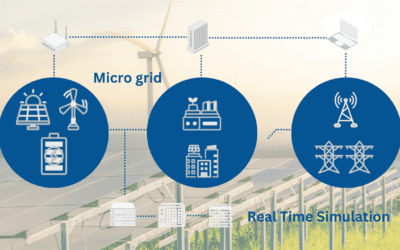Intro
Blockchain is more than just a technology. It is a way of thinking where trust, transparency, security, sharing, and collaboration are the foundations. In this COVID-related period, we all have experienced the importance of these values: I think now is the time where we apply what we’ve learned during the lockdown period to make the world a better place.
In this post, I’ll storytell how at i-EM we are using the blockchain technology in the e-Mobility sector.
First of all: what is a blockchain?
(Our) Blockchain in a nutshell
In general, Blockchain is a type of distributed ledger technology. That is, databases that are shared by a group of peers and spread and synchronized across a network. The network can be spread across multiple sites, countries or institutions. Records are stored in a continuous ledger and ledger data can be public or restricted to a defined group [1].
While it is true that can be used in other context (such as bit currency activities), in our activity the blockchain is used a shared databased where each member can have access to the relevant information, ensuring trustiness between all players. In particular, payment transactions can be traced with no need of intermediaries (such as banks!) Which kind of payment, do you ask? The e-Mobility ones is the answer. That is, for example: you own an e-vehicle, and you want to recharge your car. You go to the e-charging station near your job place and, using a simple app powered by blockchain tech, you smart-pay. No money contact, no specific need of banks transactions, no pain.
You can certainly see a lot of benefits, don’t you? In the case you forgot some, I list them here.
Benefits
- Less number of players -> less intermediaries, less commissions.
- Payment methods: between others, cryptocurrency can be used, making it a business model currency independent that can also be applied to different kind of charging stations.
- Trust: you know the players, and the insurance companies involved have automatically all data they need in case of issues.
- Unchangeable data: you cannot change data that was sent
- Independency from large companies: this technology is peer-centered.
- Transparency: everyone in the blockchain can see the data
- Smart contract easy to create
- oh, and you have comfy and often free parking, too!
As in every real-life situation, there are also some issues:
- Control of servers: it is not always clear in open blockchain who controls the servers and in which part of the world they are located
- Dependency of one blockchain system: not easy to change from one blockchain to another, which makes you dependent on the system you started with
With the rise in adoption of EVs by 2050 and the aggressive targets for carbon footprint the implementation for electrical vehicle (EV) charging infrastructure are in demand. Also, the governments all around the world are giving more and more attention to electrical mobility experience, also with money incentives.
Thus, now is a good moment to think about e-Mobility services: in the short-term, you can focus on simpler and no-contacts payment methods for e-vehicles; in the long terms, thinking on autonomous cars that can automatically interact with e-vehicle charging stations without the need of the physical human interaction.
As you can see, e-Mobility and blockchain are a very good match!
Success case
The Kick-Start activity of SENECA (Space Enabling blockchaiN for Emobility appliCAtions) aims to provide blockchain-enabled services to manage the energy flow between e-vehicles and the grid using space-assets. The goal of the related solutions is to allow the users to perform energy-transactions in a secure and agile blockchain environment, where smart contracts enable the utilization of e-vehicles battery in relationship with renewable energy availability, facilitate e-vehicles fleet management needs, and finally support the electrical grid necessities.
Three services, corresponding to three potential final-users: one for the e-driver, one for the e-fleet manager, and finally one for the e-Mobility service provider. Below a list with a preliminary description.
- G2V (Grid To Vehicle): for the e-driver, using smart-contracts coding embedded in the blockchain, the energy flow can be optimized to obtain i) the cheaper price ii) 0-km energy iii) CO2-free energy source iv) faster charging time. Smart contracts are computerized instructions aimed at automatically placing transactions, mathematically guaranteeing promises between partners. Additionally, electric vehicles could request high power peaks to be recharged in a fast manner (e.g., railway stops, shopping parking), that must be taken care of in high-quality energy-balancing activities.
- V2F (Vehicle To Fleet): for the e-vehicles fleet manager, artificial intelligence algorithm perform route-profiling, used to suggest to the e-driver the best route to free charging station (in case of public CS), to avoid congestions and queues on charging stations and optimize the fleet management. Also, assistance for insurance companies could be provided with geo-localized data.
- V2G (Vehicle To Grid): for the e-Mobility Service Provider, using smart-contracts coding embedded in the blockchain, the energy flow can be optimized to avoid grid disturbances from solar and wind power sudden increase/decrease using the e-vehicle as a buffer-battery, rewarding the e-driver for having his/her vehicle used as temporary storage system to alleviate grid-congestions. The corresponding transaction value could be exchanged in the form of tokens with specific currency denominations; users could be free to use them in other services (e.g., the next recharge) or redeem them for cash. Weather nowcasting is used to predict this kind of sudden peaks.

Figure 1: How Smart charging enables EVs to provide flexibility
Other services at i-EM
i-EM is under developing different services in the e-Mobility field, to provide services at different stage of the value chain: from planning to monitoring, to operation and maintenance.
For example, eV-EM (electric Vehicles Energy Management system) is an EV Charging Station Planner, developed from i-EM for DSO and CPOs. The main features are:
- Optimal Charging Station Planner considering different information layers.
- Several Information layers: population density, shopping centers, traffic info, parking areas, public transport stations.
- Information layers importance can be defined by the users.
- Plans history according to each location (urban area).
- Plans database across all locations (different urban areas).

Figure 2: eV-EM Planning

Figure 2: eV-EM Plan Summary
Final words
E-Mobility is expected to have a huge impact on the electric grid, with 200 million EVs expected to be in use by 2030, 11.9 billion kW of peak capacity and $98 billion of power consumption (World Energy Insights Brief, 2018). The highly fragmented EV charging market, such as current, leads to an uncomfortable driver’s experience, an increased complexity and overload of the grid and the under-utilisation of the infrastructure. To enhance the driver’s experience, and consequently the penetration of EVs, new e-Mobility services will be developed and introduced in the market: standard and secure technologies, such as blockchain, can have a big role in facilitate the diffusion of such applications and services.
Notes
[1] 7 BLOCKCHAIN MYTHS DEBUNKED; WHAT BLOCKCHAIN IS AND WHAT IT ISN’T https://www.ico.li/7-blockchain-myths-debunked/. (See reference)For the curious costumer
At i-EM S.r.l. we have what you need (we hope!)… Try us!
For the keen reader
- Blockchain in the E-mobility chain:
https://www.greenflux.com/blockchain-in-the-emobility-chain/. - Five things that must happen for blockchain to see widespread adoption, according to Deloitte: https://www.cnbc.com/2018/10/01/five-crucial-challenges-for-blockchain-to-overcome-deloitte.html.
- Blockchain-Based Mobility-as-a-Service (IEEE): https://ieeexplore.ieee.org/abstract/document/8847027.
- Blockchain Initiative Map: https://www.eublockchainforum.eu/initiative-map
- How auto pioneers are taking the plunge into blockchain (IBM): https://www.ibm.com/thought-leadership/institute-business-value/report/autoblockchain.
- Mobility as a Service Market by Service:
https://www.researchandmarkets.com/reports/4825469/mobility-as-a-service-market-by-service-ride?gclid=Cj0KCQjw9tbzBRDVARIsAMBplx9yQcda_T9ATLvpkZ9Wquc51l2ivy9H2ktyEncYBpDbaEBh9xZGoTsaAqxWEALw_wcB. - https://www.marketsandmarkets.com/Market-Reports/mobility-as-a-service-market-78519888.html.
- Mobility as a Service Market by Service:
https://www.researchandmarkets.com/reports/4825469/mobility-as-a-service-market-by-service-ride?gclid=Cj0KCQjw9tbzBRDVARIsAMBplx9yQcda_T9ATLvpkZ9Wquc51l2ivy9H2ktyEncYBpDbaEBh9xZGoTsaAqxWEALw_wcB.
Author
Fabrizio Ruffini, PhD
Senior Data Scientist at i-EM







